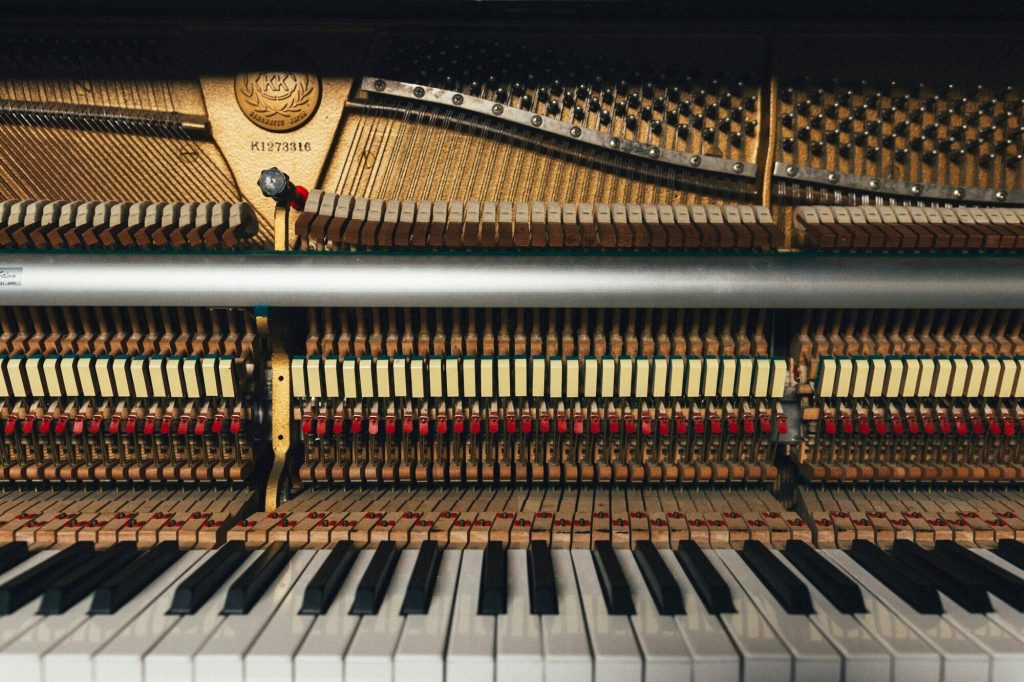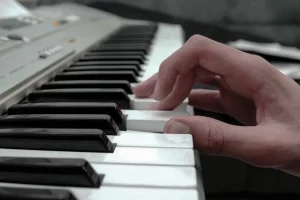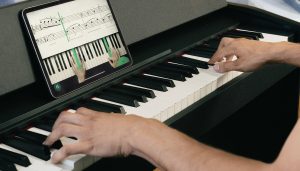In music, certain fundamental components, known as the elements of music, serve as the essential building blocks for all musical compositions. These elements provide the framework within which the rich tapestry of melodies, rhythms, and harmonies is constructed, offering both composers and performers the tools to communicate their artistic vision.
Understanding the musical elements is crucial for anyone learning to play the piano or any other musical instrument. These elements are more than just theoretical concepts; they are the very aspects of music that give it form and character. From the simplest melodies to the most complex symphonies, the musical elements are present, guiding the creation and interpretation of music.

Rhythm
Rhythmic foundations: beat and meter
Rhythm refers to the pattern of sounds and silences in music, which occurs through a sequence of beats and the spaces between them. The beat is the basic unit of time in a piece of music, and it is what gives music its regular rhythmic pattern. Meter, on the other hand, organizes these beats into regular groupings, typically heard as the music’s “pulse”. This grouping of beats is what we tap our feet to when we listen to a song.
For example, a common meter in music is the 4/4 time signature, where each grouping consists of four beats. This can be heard in many popular songs and classical compositions alike. In contrast, a 3/4 meter, with its waltz-like rhythm, offers a different feel, emphasizing a pattern of three beats per measure.
Tempo: the speed of music
Tempo, another critical aspect of rhythm, refers to the speed at which a piece of music is played. It is what dictates whether a piece feels slow and solemn or fast and energetic. The tempo of a piece significantly affects its mood and style, influencing the listener’s emotional response.
Composers often use Italian terms to indicate tempo, such as “Allegro” for fast, “Moderato” for moderate, and “Adagio” for slow. Changing the tempo within a piece can create contrast and interest, making it a powerful tool in the hands of skilled composers and performers.
Melody
Melody consists of a sequence of notes that are perceived as a single entity. These notes, when played in succession, create a tune or theme that is easily memorable and often carries the emotional weight of the piece.
At the foundation of melody are scales, which are sequences of notes arranged in a specific order of pitch. Scales can vary in their structure, with the most common being the major and minor scales in Western music. These scales provide the framework within which melodies are constructed. For example, a melody composed using a major scale typically conveys a happier, more upbeat emotion, whereas a melody in a minor scale might evoke a sense of sadness or introspection.
Melodic expression: phrases and themes
Melodies are further divided into phrases, akin to sentences in language, which often conclude with a sense of musical resolution. These phrases are strung together to form larger units called themes, which are the central ideas or motifs of a piece. The way melodies are constructed – their contour, range, and the intervals between notes – significantly impacts how they express emotion and character.
Understanding the nuances of melody, including its construction and expressive capabilities, is crucial for piano learners. It enables them to interpret and convey the intended emotion and character of a piece effectively. A well-crafted melody is not only memorable but also evokes a range of emotions, making it a critical element in the musical experience.
Harmony
Harmony, in the context of music, refers to the simultaneous combination of notes and the relationships between these notes when they are played together. It adds depth and richness to a melody, often creating an emotional backdrop that enhances the listening experience. At the core of harmony are chords, which are groups of notes played together to produce a harmonious sound.
Chords are built on scales and typically consist of three or more notes. The most basic type of chord is the triad, which includes the root note, its third, and fifth. The way these chords are sequenced is known as chord progressions, and they play a pivotal role in defining the mood and direction of a piece. For instance, a chord progression can lead the music towards a resolution or create a sense of tension and anticipation.
The role of harmony in music
Harmony supports and complements the melody, often bringing a fuller and more complex sound to a piece of music. It can reinforce the emotional content of a melody, provide contrast, or add layers of complexity to a musical composition. In piano music, harmony is typically expressed through the left-hand accompaniment, while the right hand plays the melody.
Timbre
Timbre (pronounced tam-ber) is the unique quality or color of a sound that distinguishes one source or musical instrument from another. It is the characteristic that enables us to identify different types of sounds, such as the distinct resonance of a piano versus the vibrant tones of a violin, even when they play the same musical elements.
In piano music, an instrument central to many music elements examples, timbre varies with the make and model of the piano, the materials used in its construction, and the playing technique. The same melody can sound markedly different on a grand piano as compared to an upright or an electronic keyboard, illustrating the profound impact of timbre on the aspects of music.
The concept of timbre extends beyond instruments to the realm of vocal qualities. Each singer’s voice has a unique timbre, making it possible to distinguish different voices. This variation in vocal timbre adds another layer to the interpretation of music elements, contributing to the rich diversity of musical expression.
Dynamics
Dynamics are the variations in loudness or softness in a musical piece. They play a crucial role in conveying the emotional content of music, adding expressiveness and depth. Dynamics are indicated in musical notation by specific symbols and Italian terms, such as “forte” (loud), “piano” (soft), “crescendo” (gradually getting louder), and “decrescendo” (gradually getting softer).
In piano music, the use of dynamics is particularly impactful. The ability of the instrument to produce a wide range of volumes allows for significant expressive flexibility. For instance, a sudden shift from a gentle, quiet passage (pianissimo) to a loud, forceful one (fortissimo) can dramatically alter the mood and intensity of a piece.
Dynamics in music notation
Understanding how to read and interpret dynamic markings is essential for piano learners. It allows them to grasp the composer’s intentions regarding the musical elements and the emotional nuances they are meant to convey. Proper use of dynamics enhances the musical expression, making a performance more engaging and moving.
The effect of dynamics on emotional expression in music cannot be overstated. It is one of the music elements examples that show how subtle changes in volume can significantly impact the listener’s experience, drawing them deeper into the essence of the music.
Texture
Texture refers to the way different melodic, rhythmic, and harmonic elements are combined in a composition, determining how they interweave and interact with each other. It’s a crucial part of the basic elements of music, contributing significantly to the complexity and richness of a piece. The main types of musical textures are:
- Monophonic: Monophonic texture is a single melodic line without accompaniment, showcasing the melody in its purest form.
- Polyphonic: Polyphonic texture is multiple melodic lines played simultaneously, each with equal importance, often creating a complex and intricate texture.
- Homophonic: Homophonic texture is one dominant melody accompanied by chords, where the accompaniment supports the main melody.
Each type of texture offers a different listening experience and is used by composers to achieve various musical effects and emotional responses.
Form
Form in music is the structure or blueprint of a piece, outlining how its sections are organized and developed. It is one of the essential elements of music that gives a composition its shape and coherence. Understanding musical forms is crucial for both composers and performers, as it helps in the creation and interpretation of music. Common forms in music include:
- Sonata: Sonata form is a complex form typically used in classical music, consisting of several movements with contrasting tempos and characters.
- Rondo: Rando form is characterized by a recurring theme that alternates with different sections or episodes.
These forms, along with others like the symphony, concerto, and fugue, represent the diverse ways in which the basic elements of music can be arranged to create meaningful and impactful musical narratives.
Tonality
Tonality is a fundamental concept in the world of music, particularly in Western classical and popular music. It is the system of organizing musical compositions around a central note, scale, or key, giving the piece a sense of harmonic direction and coherence. This central note, or the tonic, is the ‘home base’ to which the music often returns, creating a sense of resolution and stability.
Understanding tonality is crucial for grasping the essence of the essential elements of music. It helps in comprehending how melodies and harmonies are constructed and how they interact within a piece. Tonality can evoke a wide range of emotions and atmospheres, from the cheerful brightness of a major key to the introspective depth of a minor key.
Relationship with melody and harmony
Tonality ties closely with other musical elements, particularly melody and harmony. The melodic contour and harmonic progression of a piece are often dictated by its tonal center, influencing the overall mood and character of the music. In piano music, tonality is a key aspect that guides the pianist’s interpretation of a piece, influencing everything from phrasing to dynamics.
For beginners learning piano, an understanding of tonality is part of the foundational knowledge that enhances their musical literacy. It allows them to appreciate the structural aspects of music and aids in their journey of musical exploration and expression.
The symphony of musical elements
A solid understanding of these elements of music is vital for students of music theory. It forms the bedrock of their musical education, equipping them with the knowledge needed to read, analyze, and create music. For those engaged in music appreciation, familiarity with these elements enables a deeper understanding of musical compositions, enhancing the listening experience by revealing the intricacies and nuances of musical works.
As you continue to explore and learn, remember that each of these elements is a thread in the greater weave of music, and it’s the symphony of their combination that creates the beauty and power of the music we love.
Author of this blog post:
Susana Pérez Posada

With over seven years in piano education and a deep passion for music therapy, Susana brings a unique blend of expertise to Skoove. A graduate in Music Therapy from SRH Hochschule Heidelberg and an experienced classical pianist from Universidad EAFIT, she infuses her teaching with a holistic approach that transcends traditional piano lessons. In her writings for Skoove, Susana combines her rich musical knowledge with engaging storytelling, enriching the learning experience for pianists of all levels. Away from the piano, she loves exploring new places and immersing herself in a good book, believing these diverse experiences enhance her creative teaching style.
Edited and fact-checked by Eddie Bond, multi-instrumentalist performer, composer, and music instructor
Published by Lidya Hovan from the Skoove team















